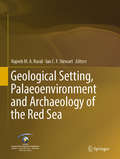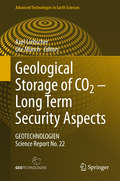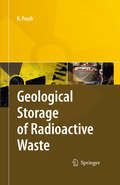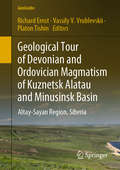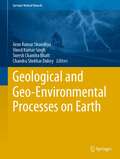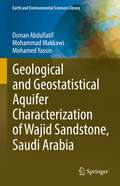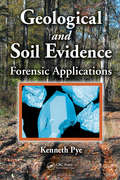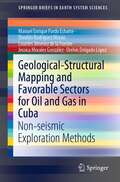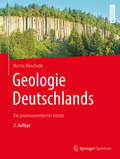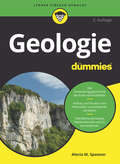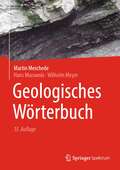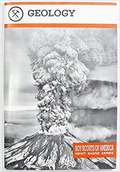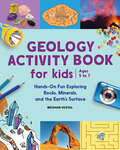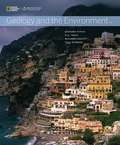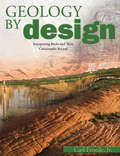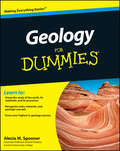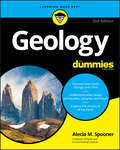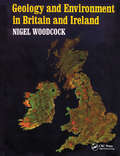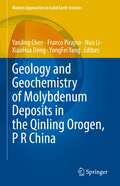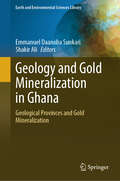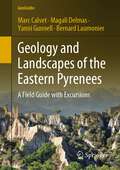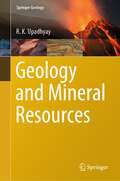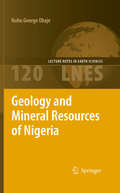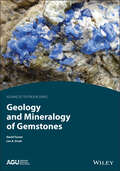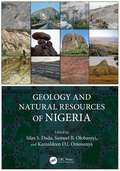- Table View
- List View
Geological Setting, Palaeoenvironment and Archaeology of the Red Sea (Environmental Earth Sciences Ser.)
by Najeeb M.A. Rasul Ian C.F. StewartThis book gathers invited contributions from active researchers to provide an up-to-date overview of the geological setting of the Red Sea. It discusses aspects ranging from historical information to modern research in the Red Sea, and presents findings from rapidly advancing, emerging fields. This semi-enclosed young ocean basin provides a unique opportunity to study the development of passive continental margins in order to examine the current status of that region. In addition to studies on the Sea itself, it includes those from related fields on the littoral zone. The book is of interest to geoscientists and non-specialists alike.
Geological Storage of CO2 - Long Term Security Aspects
by Ute Münch Axel LiebscherThis book explores the industrial use of secure, permanent storage technologies for carbon dioxide (CO2), especially geological CO2 storage. Readers are invited to discover how this greenhouse gas could be spared from permanent release into the atmosphere through storage in deep rock formations. Themes explored here include CO2 reservoir management, caprock formation, bio-chemical processes and fluid migration. Particular attention is given to groundwater protection, the improvement of sensor technology, borehole seals and cement quality. A collaborative work by scientists and industrial partners, this volume presents original research, it investigates several aspects of innovative technologies for medium-term use and it includes a detailed risk analysis. Coal-based power generation, energy consuming industrial processes (such as steel and cement) and the burning of biomass all result in carbon dioxide. Those involved in such industries who are considering geological storage of CO2, as well as earth scientists and engineers will value this book and the innovative monitoring methods described. Researchers in the field of computer imaging and pattern recognition will also find something of interest in these chapters.
Geological Storage of Highly Radioactive Waste
by Roland PuschThe book describes and assesses current concepts for long-term disposal of highly radioactive waste. Different types of rock are discussed and assessed with respect to practical difficulties in the construction of a repository, and the efficiency of isolating radioactive waste. Safety matters are most important and are treated in the respective chapters and in a final, conclusive chapter. Cost issues and related quality matters are discussed for the case of constructing a virgin repository and repositories in the form of converted abandoned mines.
Geological Tour of Devonian and Ordovician Magmatism of Kuznetsk Alatau and Minusinsk Basin: Altay-Sayan Region, Siberia (GeoGuide)
by Richard Ernst Vassily V. Vrublevskii Platon TishinThis volume provides an overview and tour (with many interesting stops along the way) of Devonian and Ordovician intraplate magmatism and associated sedimentary rocks and tectonics in the regions of Kuznetsk Alatau, Minusinsk Basin and Khakassia in western Siberia. All chapters were written by experts, many of which have been studying these regions for decades. The first book to present and review this information in English for an international audience, it includes both overviews of the magmatic and associated sedimentary history, and selected key field sites, which are described in detail.
Geological and Geo-Environmental Processes on Earth (Springer Natural Hazards)
by Vinod Kumar Singh Arun Kumar Shandilya Suresh Chandra Bhatt Chandra Shekhar DubeyThis edited volume dedicated to late Prof. P.S. Saklani addresses the multidisciplinary themes pertaining to role of tectonism and magmatism in Crustal Evolution and global distribution of metallic and non metallic mineral deposits. It gives valuable information on geodynamic evolution, structural, petrological, isotopic, metamorphic, geochemical and geochronological attributes of continental and oceanic crust and is challenging reassessments of the existing paradigms. It addresses the implication of magmatism, metallogeny and application of geochronological ages (U-Pb SHRIMP age, Lu-Hf isotopic system; detrital zircons). This book also advocates the role of tectonics in contamination of ground water, and control on drainage pattern and geothermal systems. It explores the vulnerability of earth towards natural hazards viz. earthquakes, floods, cyclones, tsunami, volcanism, cyclones and drought. This volume throws light on the applications of remote sensing, GIS (Geographical Information System) and SRTM data for evaluation of the morphometric and morphotectonic parameters and exploring the susceptibility of river basins toward erosion and flood. It will be beneficial to graduate and post-graduate students as well as professionals and researchers.
Geological and Geostatistical Aquifer Characterization of Wajid Sandstone, Saudi Arabia (Earth and Environmental Sciences Library)
by Osman Abdullatif Mohammad Makkawi Mohamed YassinThe book summarizes research work on the Wajid Sandstone, which provides integrated field and laboratory data to enable a detailed description of this unit including a facies analysis, porosity data, as well as permeability data to establish aquifer models. Detailed facies analysis at outcrop scale are supported by vertical and lateral sedimentological sections, facies and environmental analysis and supplemented by detailed laboratory petrographical and petrophysical data. The analysis and interpretation of the outcrop analog models include the reconstruction of the stratigraphic architecture at outcrop scale. Moreover, the results were described statistically, analyzed and eventually establish an outcrop-based aquifer model analogue. The book benefits undergraduate, graduate and researchers working on applied sedimentological studies, hydrogeology, statistical and geostatistical analysis and modeling.
Geological and Soil Evidence: Forensic Applications
by Kenneth PyeThe forensic potential of geological and soil evidence has been recognized for more than a century, but recently these types of evidence are used much more widely as an investigative intelligence tool and as evidence in court. There is, however, still a poor understanding of the potential value and the limitations of geological and soil evidence am
Geological-Structural Mapping and Favorable Sectors for Oil and Gas in Cuba: Non-seismic Exploration Methods (SpringerBriefs in Earth System Sciences)
by Manuel Enrique Pardo Echarte Osvaldo Rodríguez Morán Orelvis Delgado López Lourdes Jiménez de la Fuente Jessica Morales GonzálezThe so-called "Non-conventional geophysical-geochemical exploration methods" are used, in the particular case of oil and gas exploration, for the detection and mapping of active microseepage of light hydrocarbons with a vertical nature on the gas-oil accumulations.The non-seismic exploration methods used in Cuba are: Remote Sensing, Gravimetry, Aeromagnetometry, Airborne Gamma Spectrometry (AGS) and Morphometry (non-conventional, from the Digital Elevation Model 90x90m). The AGS also classifies, as a non-conventional geophysical-geochemical method, together with the Redox Complex.Besides, it is of interest to know the geological-structural framework where these microseepage occur. That is why the benefits of using these methods (excluding Redox Complex), prior to their integration with geological and seismic data, translate into a first approximation, valid for an initial understanding of geology and mapping of favourable areas of possible gas-oil interest.Finally, from the implementation of these methods (including Redox Complex), perspective sectors for oil and gas are obtained, once the integration with geology and seismic has been carried out.The book presents a brief theoretical account of the methods used and, as practical results, a set of perspective sectors of possible interest for exploration in Cuba.As a complementary result, the book also offer an evaluation of the areas that meet the petroleum-geologist premises for the presence of large accumulations of high quality oil in Cuba.
Geologie Deutschlands: Ein prozessorientierter Ansatz
by Martin MeschedeDeutschland ist vom geologischen Aufbau her sehr abwechslungsreich, wie dieses Lehrbuch in anschaulichen vierfarbigen Grafiken und auch für Nicht-Geologen verständlichen Texten vermittelt. Im Norden breitet sich die norddeutsche Tiefebene aus, die von jungen Lockersedimenten bedeckt ist. Daran schließen sich die Mittelgebirge an, in denen die ältesten Gesteine Deutschlands zu finden sind, und im Süden folgen die Alpen, ein nach geologischen Maßstäben junges Hochgebirge, mit ihrer Vorlandsenke, der alpinen Molasse.- Wie sind diese unterschiedlichen Gebirge und Landschaftsformen entstanden?- Welche Gesteine bilden den geologischen Untergrund Deutschlands?- Was ist der Grund dafür, dass Erdbeben nur in bestimmten Regionen Deutschlands auftreten?- Wo gibt es junge Vulkane und warum sind sie einst ausgebrochen?- Wie sind all diese Erscheinungen in das plattentektonische Geschehen in Mitteleuropa eingebunden?- Wie wurde schließlich die heutige Landoberfläche geformt?Auf all diese Fragen geht Martin Meschede im vorliegenden Buch ein und zeichnet die Entwicklung Deutschlands nach von seinen Anfängen auf verschiedenen Kontinenten bis hin zum heutigen Nebeneinander der unterschiedlichen Struktureinheiten.
Geologie für Dummies (Für Dummies)
by Alecia M. SpoonerEiszeiten, Vulkanismus, Erosion, Meteoriteneinschläge - unser Planet hat in seiner Geschichte schon einiges mitgemacht. Und so vielgestaltig die Erde aussieht, so umfangreich und komplex ist auch das Thema Geologie. Aber keine Sorge, Alecia Spooner erklärt Ihnen leicht verständlich alles Wichtige, was es zum Thema Geologie zu wissen gibt: von den chemischen Grundlagen und der Bedeutung von Wind und Wasser für die Geowissenschaften bis zur Bildung und Bestimmung von Gesteinen. Sie erfahren alles Wissenswerte zu Konvektion, Plattentektonik, Mineralien, Fossilien, Erdbeben, Oberflächenprozessen, den geologischen Zeitaltern und vieles mehr.
Geologisches Wörterbuch
by Martin Meschede Hans Murawski Wilhelm MeyerVon Aa-Lava bis ZylinderfalteÜber 5000 Begriffe aus der Geologie und ihren Nachbarwissenschaften stellt das Geologische Wörterbuch anhand kurzer Erläuterungen und einer Vielzahl von erklärenden Abbildungen vor. Das Buch wendet sich sowohl an Fachleute als auch an die Liebhaber der Geowissenschaften. Es will zum Verstehen geowissenschaftlicher Texte beitragen und ist zugleich ein wichtiger Studienbegleiter für angehende Geowissenschaftler.Die 13. Auflage wurde vollständig überarbeitet und neugestaltet. Die Begriffe wurden konsequent im Sinne der aktuell gültigen Theorie der Plattentektonik erläutert, wobei alte, überkommene Begriffe (wie z. B. Geosynklinale) nicht herausgenommen, sondern mit entsprechenden Erklärungen versehen und als heute nicht mehr verwendet gekennzeichnet wurden. Neu hinzugekommen ist die englische Übersetzung für jeden einzelnen Fachbegriff als Hilfestellung zum Verfassen geowissenschaftlicher Texte in englischer Sprache. Sämtliche Abbildungen sind in der neuen Ausgabe farbig angelegt. Sie wurden z. T. aus der vorherigen Auflage in überarbeiteter Form übernommen, zum größten Teil aber ganz neu erstellt.
Geology (Merit Badge Ser.)
by Boy Scouts of America StaffThis merit badge pamphlet gives Scouts the resources they need to learn earn the Geology merit badge! It is a comprehensive look into the science of Geology and gives Scouts the knowledge to apply it to their environment.
Geology Activity Book For Kids: Hands-On Fun Exploring Rocks, Minerals, and the Earth's Surface
by Meghan VestalHelp kids discover how mountains are formed and rocks are made with this interactive geology book for ages 5-7Learning about rocks and minerals is a lot more fun when kids can get their hands dirty. This book on rocks teaches budding scientists all about planet Earth through 19 geological topics that feature hands-on experiments, on-page activities, and fascinating facts.What sets this geology book apart from other rock books for kids:Real-life experiments—Kids can see what it's like to be a geologist with simple yet fascinating experiments such as pulling core samples from a candy bar, growing crystals, and creating a volcanic eruption!Earth-based activities—A variety of games, puzzles, and facts help young readers better understand geological concepts and build their scientific vocabulary.Rock spotting—This is also a rock identification book where kids can learn how to identify the rocks and minerals being used in the world around them, from the kitchen to the classroom.Inspire geology kids with this interactive exploring nature activity book—it's a standout among geology books for kids.
Geology And The Environment
by Richard Hazlett Paul Bierman Bernard Pipkin Dee TrentCengage Learning's GEOLOGY AND THE ENVIRONMENT, in partnership with the National Geographic Society brings course concepts to life with interactive learning, study, and exam preparation tools along with market leading text content for introductory geology courses. Whether you use a traditional printed text or all digital GEOLOGY AND THE ENVIRONMENT alternative, it's never been easier to explore the relationship between humans and the geologic hazards, processes, and resources that surround us.
Geology By Design
by Carl Froede Jr.Presents and authoritative and biblical geological time-line for high school students and adults. Includes substantial illustrations, a glossary, and an extensive reference section. Clearly explains how data from volcanic deposits, seismic activity in Earth history, and even the presence of ripple marks in rock layers support the Bible as history. From the acclaimed Creation Research Society, this technical study of rock strata, and the fossils found therein, gives a solidly scientific rationale for believing in a young earth. This advanced guide is ideal for upper-level homeschool students, college students, or anyone wishing to explore this fascinating subject in-depth and includes questions for review at the end of each chapter. Froede presents a credible geological time-line and explains the formation and existence of fossil layers in rock sediments around the world.
Geology For Dummies
by Alecia M. SpoonerGet a rock-solid grasp on geologyGeology is the study of the earth's history as well as the physical and chemical processes that continue to shape the earth today. Jobs in the geosciences are expected to increase over the next decade, which will increase geology-related jobs well above average projection for all occupations in the coming years.Geology For Dummies is the most accessible book on the market for anyone who needs to get a handle on the subject, whether you?re looking to supplement classroom learning or are simply interested in earth sciences. Presented in a straightforward, trusted format, it features a thorough introduction to the study of the earth, its materials, and its processes.Tracks to a typical college-level introductory geology courseAn 8-page color insert includes photos of rocks, minerals, and geologic marvelsCovers geological processes; rock records and geologic times; matter, minerals, and rock; and moreGeology For Dummies is an excellent classroom supplement for all students who enroll in introductory geology courses, from geology majors to those who choose earth science courses as electives.
Geology For Dummies
by Alecia M. SpoonerGet a rock-solid grasp on geology Geology For Dummies is ideal reading for anyonewith an interest in the fundamental concepts of geology, whether they're lifelong learners with a fascination for the subject or college students interested in pursuing geology or earth sciences. Presented in a straightforward, trusted format—and tracking to a typical introductory geology course at the college level—this book features a thorough introduction to the study of earth, its materials, and its processes. Rock records and geologic time Large-scale motion of tectonic plates Matter, minerals, and rocks The geological processes on earth's surface Rock that geology class with Geology For Dummies!
Geology and Environment In Britain and Ireland
by Nigel WoodcockA complete introductory text on an increasingly popular subject, "Geology and Environment in Britain and Ireland" aims to provide suitably broad coverage for students requiring a treatment clearly foucused on familiar examples but retaining a global perspective. The book summarizes for Earth and environmental scientists the ways in which geology re
Geology and Geochemistry of Molybdenum Deposits in the Qinling Orogen, P R China (Modern Approaches in Solid Earth Sciences #22)
by Franco Pirajno YanJing Chen Nuo Li XiaoHua Deng YongFei YangThis book is the first systematic treatise of available data and view-points obtained from geological and geochemical studies of the Mo deposits in Qinling Orogen, China. Qinling Orogen has a minimum reserve of 8.7 Mt Mo, ranking the largest molybdenum province both in China and the world. Incorporating all known Mo deposit types in the world, it presents extensive studies of Mo deposits of world-class and unusual types within tectonic settings. The Qinling Orogen was finally formed during continental collision between Yangtze and North China cratons, following the Triassic closure of the northernmost paleo-Tethys. It hosts 49 Mo deposits formed in seven mineralization events since 1850 Ma, with all the world-class deposits being formed during 160-105 Ma, coeval with collisional orogeny. These deposits are assigned to magmatic and metamorphic hydrothermal classes. The magmatic hydrothermal class includes porphyries, skarns, and intrusion-related veins (carbonatite, fluorite and quartz). The porphyry Mo systems in Qinling Orogen are predominated by Dabie-type formed in continental collision setting, followed by Endako- and Climax-types formed in continental arcs and rifts, respectively. The metamorphic hydrothermal Mo deposits are only reported in Qinling Orogen, and thus a new crustal continuum model for the orogenic class mineral systems is proposed. A scientific linkage between ore geology and fluid inclusions is introduced and verified both by theory and case studies. This is the first research book comprehensively displaying continental collision metallogeny. This literature will benefit both Western and Chinese mineral explorers and miners, as well as research scientists and students.
Geology and Gold Mineralization in Ghana: Geological Provinces and Gold Mineralization (Earth and Environmental Sciences Library)
by Shakir Ali Emmanuel Daanoba SunkariThe book provides a comprehensive overview of the various geological provinces in Ghana, with a major emphasis on the gold mineralization styles. Specifically, it elucidates the geology of Ghana in the context of gold deposits. Ghana is located in the Leo-Man Shield of the West African Craton (WAC), enriched in several precious mineral deposits, especially gold, and hence was once called &“Gold Coast&” before independence in 1957. Today, Ghana is the largest gold producer in Africa and the sixth largest globally. Gold production in the country constitutes about one-third of the country&’s total revenue. Gold deposits in Ghana have been exploited for centuries. However, except for a few isolated and, probably, old literature, knowledge gaps towards understanding gold mineralization styles in Ghana are evident. Also, studies related to the genesis of the major types of gold mineralization in Ghana are inadequate. Therefore, this book mainly focuses on comprehensively describing the geology of Ghana and establishing the link between the geology and gold mineralization. The contributions involve current state-of-the-art knowledge of gold deposits based on field studies, petrology, structural geology, geodynamic settings/tectonics, geochemistry, isotope geology, economic geology, and related studies. The book is divided into five parts, covering all the aspects of the geology and gold mineralization in Ghana. The first part introduces readers to the geology and gold mineralization styles in Ghana and provides a brief description of the occurrence and general geological features of the main gold deposit types in Ghana. The second part features the structural controls on gold deposits in Ghana since gold mineralization in the country is primarily structurally controlled. Moreover, since the gold deposits in Ghana are largely hosted in lithologies belonging to the Birimian Supergroup and the Tarkwaian Group, the petrogenesis of these lithologies is discussed in the third part. In the fourth part, the geology, mineralogy, geochemistry, fluid evolution, and genesis of hydrothermal gold deposits in Ghana are discussed. Finally, in the last part, readers will find the application of new techniques like machine learning in predicting gold-bearing lithologies in Ghana. The book would provide a conceptual framework for identifying gaps in future research on gold mineralization in the country. The book will be helpful to students/researchers/faculty members studying Earth Science-related programs and also assist industries in understanding the various rock types in Ghana and the general styles of gold mineralization. It can be used as a textbook at higher levels of education in the country and globally.
Geology and Landscapes of the Eastern Pyrenees: A Field Guide with Excursions (GeoGuide)
by Marc Calvet Magali Delmas Yanni Gunnell Bernard LaumonierThis book provides a synthesis of the physiography and geodynamics of the entire Pyrenean orogen and its foreland basins, providing the "big picture" (structure of the orogen and chronology of its formation, overview of its post-orogenic evolution, and Quaternary and recent landscape history). One part of the book proposes a 6–7 day itinerary across the eastern and east-central Pyrenees, two areas that currently provide the richest, best-documented, and most carefully curated database on the post-orogenic evolution of the mountain belt. The book deals with three complementary topics: (i) geodynamics, i.e. the long-term post-orogenic evolution of the Pyrenees since the declining stages of tectonic collision ca. 30 million years ago, and within the wider reference frame of Iberia, the Western Mediterranean, and the Atlantic margin; (ii) geomorphological processes and landforms that have conspired to shape the eastern part of the French and Spanish Pyrenees in response to base-level and climate-related changes over than same time period; (iii) geoheritage, i.e. educational vignettes of the flagship landscape units and typical geological sections of the study area. Written as a field guide, it is designed to help readers to construct discovery-based itineraries through the region (with options and variants depending on time and physical ability), allowing them to appreciate the key landscape and geoheritage features over the course of 1 week, with potential for much more.This GeoGuide is primarily aimed at confirmed geoscientists from most disciplines in Earth science, at postgraduate students engaged in field studies, and at curiosity-driven, educated amateurs keen to enhance their understanding of spectacular or enigmatic features encountered on their travels.
Geology and Mineral Resources (Springer Geology)
by R. K. UpadhyayThis book focuses on understanding Earth’s geology, its mineral resources, their exploration, and management of the environment. There are 3 parts and 12 chapters, and they provide an insight to the students of earth sciences. Part I, consisting of initial four chapters, provides snapshots on the Universe, the Earth, and its internal dynamics, and external geological processes. The mineral resources are covered in Part II with 5 chapters, featuring Earth’s elements, metals, minerals, rocks, and the mineral resources. As they are non-renewable, the importance of their scientific exploration, evaluation, mining, beneficiation, optimum utilization, and adverse impact, safety management, and environment are covered in the last 3 chapters in Part III.
Geology and Mineral Resources of Nigeria
by Nuhu George ObajeContains details on the geological units of Nigeria and the associated mineral resources. The book is divided into three parts. Part 1 discusses the geology of the crystalline rocks and their regional distribution while the sedimentary basins constitute the subject of Part 2. Part 3 takes the mineral resources of Nigeria one on one, their geological environment, mode of occurrence, localities and where possible the reserves estimation. Thereafter, an account of the previous and current mining policies (including that of petroleum) of the Nigerian government is given and goes ahead to list some specific investment opportunities in the solid minerals sector.
Geology and Mineralogy of Gemstones (AGU Advanced Textbooks)
by David Turner Lee A. GroatUnderstanding gemstones in a geological context Gemstones are colorful treasures of the Earth that have captivated humans for thousands of years. The physical and chemical characteristics of each type of gem provides insights into the geological processes that created them. Geology and Mineralogy of Gemstones is a textbook aimed at upper-level undergraduate and graduate students. It presents the basic mineralogical and geological knowledge needed to understand gemstones and examines the characteristics and geological origins of different types of gemstone. Volume highlights include: Concepts in mineralogy Structure and chemical composition of minerals Geological processes that lead to the formation and movement of gemstones Equipment and tools used to examine gemstones and their physical properties Description of small- and large-scale methods of gemstone mining The American Geophysical Union promotes discovery in Earth and space science for the benefit of humanity. Its publications disseminate scientific knowledge and provide resources for researchers, students, and professionals.
Geology and Natural Resources of Nigeria
by Silas S. Dada Samuel B. Olobaniyi Kamaldeen O.L OmosanyaGeology and Natural Resources of Nigeria is an up‑to‑date and comprehensive overview of the geological framework of the continental crust of Nigeria, its evolution, and the natural resources it holds. It covers a wide set of topics and provides a detailed description of the rock units of the Nigerian continental crust, their geological settings and structural characteristics, and the potential of their mineral, energy, and water resources. The book discusses the impact of geo‑resources on the Nigerian economy, includes recommendations on how to fully exploit geo‑resources, and explains how to prevent geological processes that could lead to natural hazards.FEATURES Provides different aspects of the Nigerian continental crust from a multidisciplinary approach Draws on the latest findings in geoscience research to present new insights and perspectives into the development and resource potential of the Nigerian continental crust Includes multiple case studies to illustrate the exploration and evaluation of the geological resources of Nigeria Explores the potential of geological resources for economic and industrial development Presents scientific achievements of authors and researchers from various disciplines and provides recommendations for mitigating natural hazards This handbook is intended for industry professionals, academics, researchers, and students studying earth sciences with a special interest in Africa and learning how its geology impacts the natural resources and overall economy of the continent.
